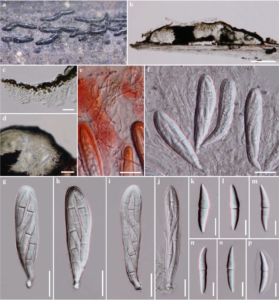Psiloglonium colihuae (Lorenzo & Messuti) E. Boehm., Stud. Mycol. 64: 71 (2009)
≡ Glonium colihuae Lorenzo & Messuti, Mycol. Res. 102(9): 1104 (1998)
Index Fungorum number: IF 515325, Facesoffungi number: FoF00435; Fig. 1
Saprobic on stems of Thysanolaena maxima. Sexual morph Ascomata 135 – 195 μm high, 590 – 970 μm diam., hysterothecial, gregarious, superficial, dark, elongate, shieldshaped, or irregular, rarely furcate, joined at ridges, with central, slit-like opening. Peridium 6 – 20 μm wide, thin-walled, of unequal thickness, poorly developed at the base, carbonaceous, opaque dark and glossy, composed of several cell layers of small, opaque, dark, dull cells arranged in textura angularis to textura globulosa. Hamathecium composed of 0.8 – 1.5 μm wide, dense, trabeculate, anastomosing, pseudoparaphyses, embedded in a hyaline to brown gelatinous matrix, slightly swollen at the apex. Asci (76–) 80 – 95 (– 120) × (15–) 17 – 18 (20) μm (x̄ = 94.5 × 18 μm, n = 25), 8 – spored, bitunicate, fissitunicate, clavate, short pedicellate with obtuse ends, apically rounded with well-developed ocular chamber. Ascospores 30 – 35 × 4 – 6 μm (x̄ = 32.9 × 5.7 μm, n = 30), overlapping 1 – 3 -seriate, fusiform with acute ends, hyaline, 1-septate, constricted at the septa, slightly curved, smooth-walled, surrounded by distinct mucilaginous sheath. Asexual morph Undetermined.
Culture characters – Colonies on PDA slow growing, 20 – 24 mm diam. after 4 weeks at 25–30 °C, grey at the magins, dark grey at the centre; reverse dark grey to black; dense, irregular, raised to umbonate, dull, undulate edge with entire magin, velvety, slightly wrinkled, producing reddish pigments in agar.
Material examined – THAILAND, Chiang Mai, Chom Tong District, Doi Inthanon, on dead stem of Thysanolaena maxima Kuntze (Poaceae), 16 November 2010, R. Phookamsak RP0094 (MFLU 11–0214, reference specimen designated here), living culture, MFLUCC 11–0178, GenBank ITS: KP744466; LSU: KP744511.
Notes – Psiloglonium colihuae was combined in the genus Psiloglonium by Boehmet al. (2009a, b). The species is poorly known and lacks sequence data in GenBank. Psiloglonium colihuae is similar to P. sasicola in the size of the ascospores, but they differ in having acute ends in P. colihuae. P. colihuae has slightly larger ascospores (30 – 43 × 4 – 9.8 μm) than P. sasicola (N. Amano) E. Boehm & C.L. Schoch (25 – 32 × 5 – 8μm). Our isolate has the same ascospore size range and acute ends as the type of P. colihuae. Therefore we treat our isolate as P. colihuae and designate our collection as a reference specimen (sensu Ariyawansa et al. 2014a). Based on multi-gene phylogenetic analyses, P. colihuae clusters with P. araucanum and a new species P. multiseptatum Phookamsak & K.D. Hyde, and is phylogenetically distinct from P. sasicola.

Fig. 1 Psiloglonium colihuae (MFLU 11–0214) a Hysterothecia black, irregular, elongate, lying on host surface. b Vertical section through hysterothecia. c, d Section through peridium. e Pseudoparaphyses stained in congo red reagent. f Asci embedded in pseudoparaphyses. g–j Asci. k–p Ascospores. Scale bars: b = 200 μm, d, f – j = 20 μm, c, e, k – p = 10 μm.
